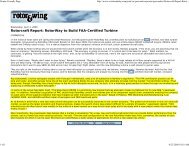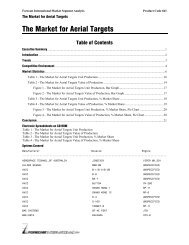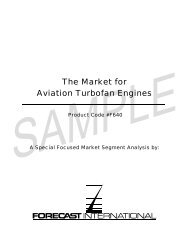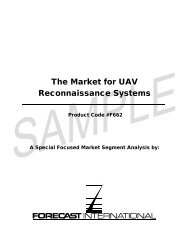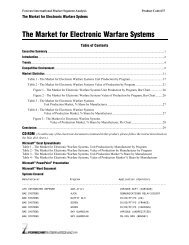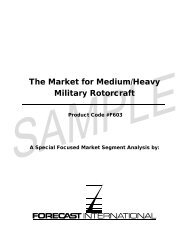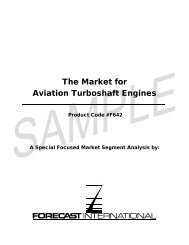The Market for Aviation Turboprop Engines - Forecast International
The Market for Aviation Turboprop Engines - Forecast International
The Market for Aviation Turboprop Engines - Forecast International
Create successful ePaper yourself
Turn your PDF publications into a flip-book with our unique Google optimized e-Paper software.
Page 4<br />
Pratt & Whitney Canada PW100 Series<br />
<strong>Aviation</strong> Gas Turbine <strong>Forecast</strong><br />
Time between overhauls is quoted by P&WC as 8,000<br />
hours <strong>for</strong> all variants except the PW123AF, which has a<br />
TBO of 2,500 hours.<br />
PW127. <strong>The</strong> PW127 series is optimized <strong>for</strong><br />
hot-and-high operation.<br />
<strong>The</strong> PW127 produces 5-10 percent more power than<br />
PW124 variants (the PW124 is no longer produced) in<br />
takeoff, climb, and cruise. <strong>The</strong> engine incorporates a<br />
higher mass-flow low-pressure compressor (LPC) of<br />
increased temperature capability. <strong>The</strong> higher<br />
temperatures result from use of single-crystal blades in<br />
the LPC.<br />
Hot section inspection is specified as necessary only "on<br />
condition." TBO is quoted by P&WC as 6,000 hours<br />
<strong>for</strong> all PW127 variants.<br />
PW130. <strong>The</strong> PW130 was proposed as a model that<br />
would add another stage to the power turbine along with<br />
other gas generator changes to achieve 3,000 shp<br />
(2,237 kW), or about 3,150 eshp. <strong>The</strong> engine was<br />
originally expected to be certificated and become<br />
available by 1994. <strong>The</strong> engine model was planned to be<br />
mated to a Hamilton Standard (now Hamilton<br />
Sundstrand) propfan gearbox and propeller to produce<br />
an estimated 7,500-8,000 lbst. Ef<strong>for</strong>ts on the PW130<br />
were shelved after a more in-depth assessment of the<br />
high end of the large turboprop-powered commuter<br />
aircraft marketplace shifted ef<strong>for</strong>ts to the PW150,<br />
described below.<br />
PW150. A major uprating of the PW100 series, the<br />
basic design is capable of 6,500-7,500 shp<br />
(4,847-5,592 kW). <strong>The</strong> machine is a three-spool freeturbine<br />
engine incorporating three axial low-pressure<br />
compressors and one centrifugal high-pressure<br />
compressor, each driven by a single axial turbine stage;<br />
this model has 75 percent more airflow than other<br />
PW100 models. A dual-channel high-per<strong>for</strong>mance<br />
ignition system is used. <strong>The</strong> 5,000-shp reduction<br />
gearbox used is the helical type found in other PW100s.<br />
<strong>The</strong> engine is equipped with a Hamilton Sundstrand<br />
dual-channel FADEC system, an engine health<br />
monitoring system, and a functionally integrated PEC<br />
(propeller electronic control). <strong>The</strong> PW150 can fit into<br />
the nacelles of other PW100 engines, making retrofit of<br />
PW150s into PW100-powered aircraft a possibility.<br />
Pratt & Whitney Canada estimated that it spent<br />
CAD250 million ($183.3 million) to develop the<br />
PW150.<br />
<strong>The</strong> PW150's first application was the Bombardier<br />
DHC-8-400, <strong>for</strong> which it is derated to 4,830 shp<br />
(3,600 kW). A total of 12 PW150 engines were used in<br />
the engine test program, while another nine were used<br />
<strong>for</strong> the DHC-8-400 certification program. <strong>The</strong> first<br />
production-standard engine was delivered to<br />
Bombardier in May 1997.<br />
Background. Initially developed as the PT7A (an<br />
improved and advanced follow-on to the widely used<br />
PT6A series), the since-redesignated United<br />
Technologies Pratt & Whitney Canada PW100 series of<br />
turboprop engines is the result of extensive design and<br />
development ef<strong>for</strong>ts under an in-house project<br />
designated ADS-604. Among the major factors driving<br />
this program, which was officially launched in 1979,<br />
were the design limitations of the PT6A series, the<br />
availability of advanced metallurgical technology not<br />
suitable to the PT6A, and the growing demand <strong>for</strong><br />
improved specific fuel consumption (SFC) among the<br />
operating community. Testing of a demonstrator engine<br />
under the ADS-604 ef<strong>for</strong>t was initiated in 1979. First<br />
testing on P&WC's Viscount testbed was conducted in<br />
1982, leading to certification in 1983. Revenue<br />
generating service began in December 1984.<br />
<strong>The</strong> PW100 engine family has accumulated more than<br />
85 million flying hours, with engines regularly<br />
achieving over 10,000 hours on-the-wing without a shop<br />
visit.<br />
Program Review<br />
P&WC PW100 Series Applications. Among the<br />
applications <strong>for</strong> the P&WC PW100 turboprop series of<br />
powerplants are the following:<br />
Aero <strong>International</strong> (Regional) ATR Series. <strong>The</strong><br />
twin-engine 46-74 seat ART 42/72 is a joint<br />
development of Aerospatiale of France and Aeritalia of<br />
Italy.<br />
<strong>The</strong> ART 42/72 series has a maximum T-O weight of<br />
47,400 pounds (21,500 kg) and a maximum range of<br />
1,440 nautical miles (2,666 km). Initially geared toward<br />
the 40-49-passenger market, the ART 42 has a high<br />
wing and a T-tail, and is powered by PW120 engines<br />
rated at 2,000 shp, providing 6 percent improvement in<br />
climb rate over the PW115. <strong>The</strong> PW121A was made<br />
available on the ART 42 as an option <strong>for</strong> hot-and-high<br />
applications. <strong>The</strong> maiden flight of the ART 42 was<br />
made in October 1984. U.S. FAA certification was<br />
obtained in October 1985.<br />
<strong>The</strong> ART 42-500, an ART 42 equipped with 2,750-shp<br />
PW127Es, became the predominant version of the<br />
November 2010



